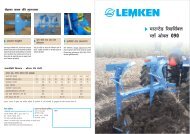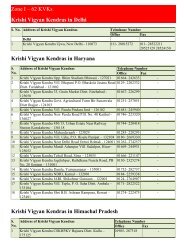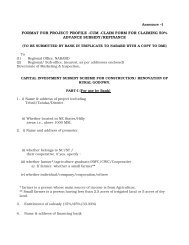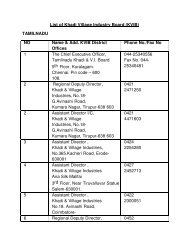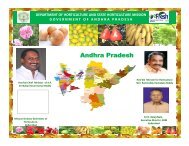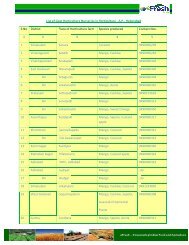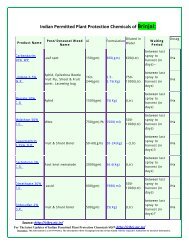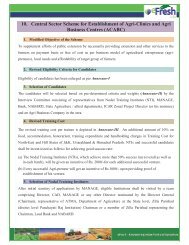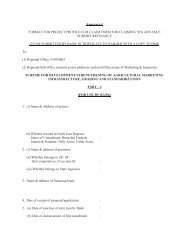Flow Chart for Mango Crop Cultivation - Efresh India
Flow Chart for Mango Crop Cultivation - Efresh India
Flow Chart for Mango Crop Cultivation - Efresh India
You also want an ePaper? Increase the reach of your titles
YUMPU automatically turns print PDFs into web optimized ePapers that Google loves.
eFresh – Empowering <strong>India</strong>n Agriculture<br />
<strong>Flow</strong> <strong>Chart</strong> <strong>for</strong> <strong>Mango</strong> <strong>Crop</strong> <strong>Cultivation</strong><br />
Selection of Site<br />
Soil and Water Testing.<br />
Preparation of Land.<br />
Layout-Alignment, Digging of pits etc<br />
Selection of planting material from the nursery<br />
Planting<br />
Care after planting-Watering, Manuring , weed<br />
control and plant protection<br />
Raising of inter crop<br />
Inter cultivation/inter culture<br />
Training and pruning of plants<br />
<strong>Crop</strong>ping-<strong>Flow</strong>ering and Fruiting – 4 th /5 th year<br />
Plant Protection during flowering and fruiting<br />
Harvesting –harvest indices, harvesting and care<br />
after harvesting<br />
Sorting of Fruits Grading , Transport to Pack<br />
Houses/Markets<br />
Note: Package may differ depending upon the type of orchard crop and agro climatic conditions
eFresh – Empowering <strong>India</strong>n Agriculture<br />
1) Selection of Site<br />
2) Soil and Water Testing.<br />
3) Preparation of Land.<br />
4) Layout-Alignment, Digging of pits etc.<br />
5) Selection of planting material from the nursery.<br />
6) Planting.<br />
7) Care after planting-Watering, Manuring, weed control and plant protection.<br />
8) Rising of inter crop.<br />
9) Inter cultivation/inter culture.<br />
10) Training and pruning of plants.<br />
11) <strong>Crop</strong>ping-<strong>Flow</strong>ering and Fruiting – 4 th /5 th year.<br />
12) Plant Protection during flowering and fruiting.<br />
13) Harvesting –harvest indices, harvesting and care after harvesting.<br />
14) Sorting of Fruits Grading, Transport to Pack Houses/Markets.
eFresh – Empowering <strong>India</strong>n Agriculture<br />
Brief insight in to each of the above operation<br />
1. Selection of Site<br />
Select site-climate should be suitable, free from gales, strong winds, hail storms and<br />
frost.<br />
Adequate water of good quality (water table in green or brown zone).<br />
Available at less cost.<br />
2. Soil and Water Testing<br />
To know suitability of soil, and its fertility, whether nature of soil and soil depth meet<br />
crop requirement.<br />
Water testing is essential to know quality of water or use amendment to suit mango<br />
crop.<br />
3. Preparation of Land.<br />
Land preparation essential to remove roots of felled trees, expose dormant pests and<br />
disease organisms to unfavorable conditions like high temperature, light and<br />
predators.<br />
On the hills, sloping lands, land may be divided in to terraces depending on<br />
topography. Contour lines when slope is 3-10% & terracing when slope is more than<br />
10%.<br />
4. Layout-Alignment, Digging of pits etc<br />
a) Layout-Alignment<br />
Lay out and alignment should be such that,<br />
Each variety of mango is allotted to one block.<br />
Varieties coming to harvest at same time may be grouped together.<br />
Pollirizers may be provided.<br />
Roads occupy minimum space.<br />
Wind breaks and shelter belts planned at right angle to direction of wind.<br />
Trees attracting birds and animals -planted near the watchmen shed.<br />
Short growing trees allotted in front and tall at back <strong>for</strong> proper supervision and<br />
aesthetic look.
eFresh – Empowering <strong>India</strong>n Agriculture<br />
b) Digging of pits etc<br />
• Pits of 3x3x3’ dimensions are dug at recommended spacing.<br />
• Pits are allowed to weather <strong>for</strong> few weeks be<strong>for</strong>e planting.<br />
• The pits are filled with top soil mixed with FYM and 2 kg single superphosphate and<br />
200g of follidol dust against termites.<br />
• Watering should be given <strong>for</strong> settling of soil in the pits.<br />
• In the event of depression, add soil and level to keep it ready <strong>for</strong> planting.<br />
5. Selection of Planting Material from the Nursery<br />
6. Planting<br />
• Obtain best plants from nursery.<br />
• Buy from the reputed nurseries that guarantee plants true to the variety.<br />
• Select 1 to 1 ½ year old plants.<br />
• Union between root stock and scion should be smooth and firm.<br />
• Joint should be 20 cm above ground.<br />
• There should not be growth on root stock.<br />
• Make hole in the middle of the pit more than that the size of the ball of earth of the<br />
plant.<br />
• Without disturbing the roots of grant, plant in such a way that the grant union<br />
remains 15-20cm above soil surface.<br />
• Cover the soil around the ball of earth and roots and compact it without leaving any<br />
air spaces. This makes the root to establish contact with soil and secure water and<br />
nutrients.<br />
• To prevent damage from blowing winds, stake the plant with support.<br />
• Make basins of 45cm around each plant.<br />
• Irrigate gently, preferably with rose can after planting.<br />
• Irrigate at 7-10 days interval depending on soil and climate from establishment time<br />
till 2 years.
eFresh – Empowering <strong>India</strong>n Agriculture<br />
7. Care after planting-Watering, Manuring, weed control and plant protection<br />
• Apply recommended dose of chemical fertilizers as per the schedule in split doses.<br />
• Irrigation scheduling should be done based on soil type and climate, normally at 7-10<br />
days interval.<br />
• In young gardens plough the inter spaces <strong>for</strong> infiltration water in rainy season, check<br />
the weed growth and destroy the insect pests and diseases .<br />
• Use atrataf (weedicide) @800g per acre to control the dicot weeds.<br />
• Spray of glyphosate @ 10ml + 20g of ammonium sulphate or 10g urea per liter of<br />
water on grassy weeds (with directional spray protecting mango crop,) controls grassy<br />
weeds.<br />
• Neem based products control most of the sucking insect pests. Spraying of a contact<br />
or systemic chemical insecticides keeps other pests in check.<br />
• Spraying of copper oxy chloride, carbandezine, Dithane M-45 and Dithane Z-78<br />
controls most of the diseases in orchard crops.<br />
8. Raising of inter crop.<br />
• Inter cropping: Raising of non-competitive and compatible crops, prevents weed<br />
growth and gives additional income till orchard reach’s bearing stage.<br />
• <strong>Crop</strong>s like vegetables, green gram and cowpea are beneficial inter crops.<br />
• Shade loving plants like ginger and turmeric can also be raised.<br />
• Soil exhaustive crops like sugarcane and maize, mealy bug favoring red gram, zinc and<br />
potash exhaustive hybrid napier are to be avoided.<br />
9. Inter cultivation/inter culture<br />
• <strong>Mango</strong> crop starts bearing from 2-3 years onwards to 4 to 5 years. Hence plants<br />
should be properly trained during first 3-4 years to build up strong frame work.<br />
• The young grant should be given support with bamboo stakes to avoid the breakage<br />
of bud union and to support main stem.<br />
• Plants make vigorous growth in first year. Allow main branch to grow to<br />
recommended height (100cm) later permit recommended number of secondaries and<br />
laterals to <strong>for</strong>m a good frame work to take burden of good bearing later on.<br />
• Pruning in orchard crops is essential to maintain balance between vegetative and<br />
reproductive growth, to regulate size and quality of fruits by way of proper<br />
distribution of fruiting area.
eFresh – Empowering <strong>India</strong>n Agriculture<br />
• Pruning is essential to regulate succession of crop.<br />
• In pruning that part of wood which is not essential <strong>for</strong> fruiting is to be removed.<br />
• Pruning is skilled operation and should be done by a professional.<br />
• Inflorescence stalks after bearing, criss cross branches, dried & diseased branches<br />
should be pruned. Pruning helps <strong>for</strong> better spread of solar radiation.<br />
• If crop is properly maintained with recommended fertilizer application and desired<br />
irrigation schedule and protected from insects and diseases, it reaches flower and<br />
fruiting stage earlier than used.<br />
• High density and ultra-high density planting in mango hastens flowering and fruiting<br />
to 2 years.<br />
10. <strong>Crop</strong>ping-<strong>Flow</strong>ering and Fruiting – 4 th / 5 th year.<br />
• Plant protection during flowering and fruiting: <strong>Flow</strong>ering period in orchard crop lasts<br />
<strong>for</strong> 2 to 2 ½ months. Special attention should be given to plant protection during this<br />
period, if not checked in time, the diseases and insects can wipeout entire crop.<br />
• Prophylactic measures not only control pests well but leave no chemical residues in<br />
fruits to get good price in the market.<br />
11. Harvesting – Harvest indices, harvesting and care after harvest<br />
• <strong>Mango</strong>s crops picked either prematurely or too late are more susceptible to post<br />
harvest physiological disorders and diseases than fruits gathered at proper stage of<br />
maturity.<br />
• Hence harvesting should follow proper indices.<br />
• Most of the indices are size and shape of fruit, overall color, and skin and flesh color,<br />
fruit firmness, soluble solid content, starch content, acid content and internal<br />
ethylene concentration.<br />
• Normally mango fruits harvested earlier than ripening stage and are ripened<br />
artificially later on as per market demand.<br />
• Harvesting is done by harvesting with tools devises by improvement if tradition ones.<br />
• The aim is that the harvested fruits should not fall directly on the ground and get<br />
damaged in the process of harvesting.
eFresh – Empowering <strong>India</strong>n Agriculture<br />
• After harvest, post harvest treatments done with chemicals or transferred to cold<br />
chambers to hasten or delay ripening, to reduce weight loss in ripening, <strong>for</strong> better<br />
color development and to prevent development of moulds and other diseases in post<br />
harvest period .<br />
12. Sorting of Fruits, Transport to Pack Houses/Markets<br />
• Sorting is done to grade them in to different sizes and quality and<br />
add value to them to fetch more price in markets or through<br />
export.<br />
• The transport to packed houses or market should be quick and<br />
efficient. The produce carefully packed, loaded and hauled to<br />
prevent any damage during the transit.




